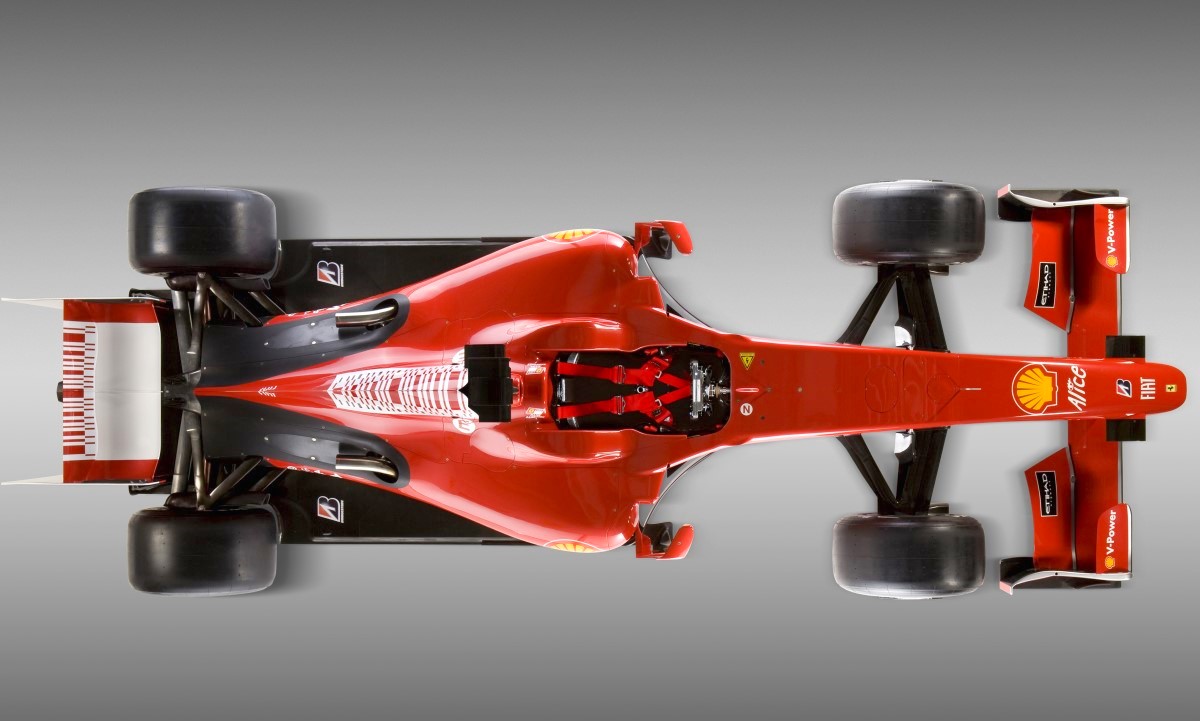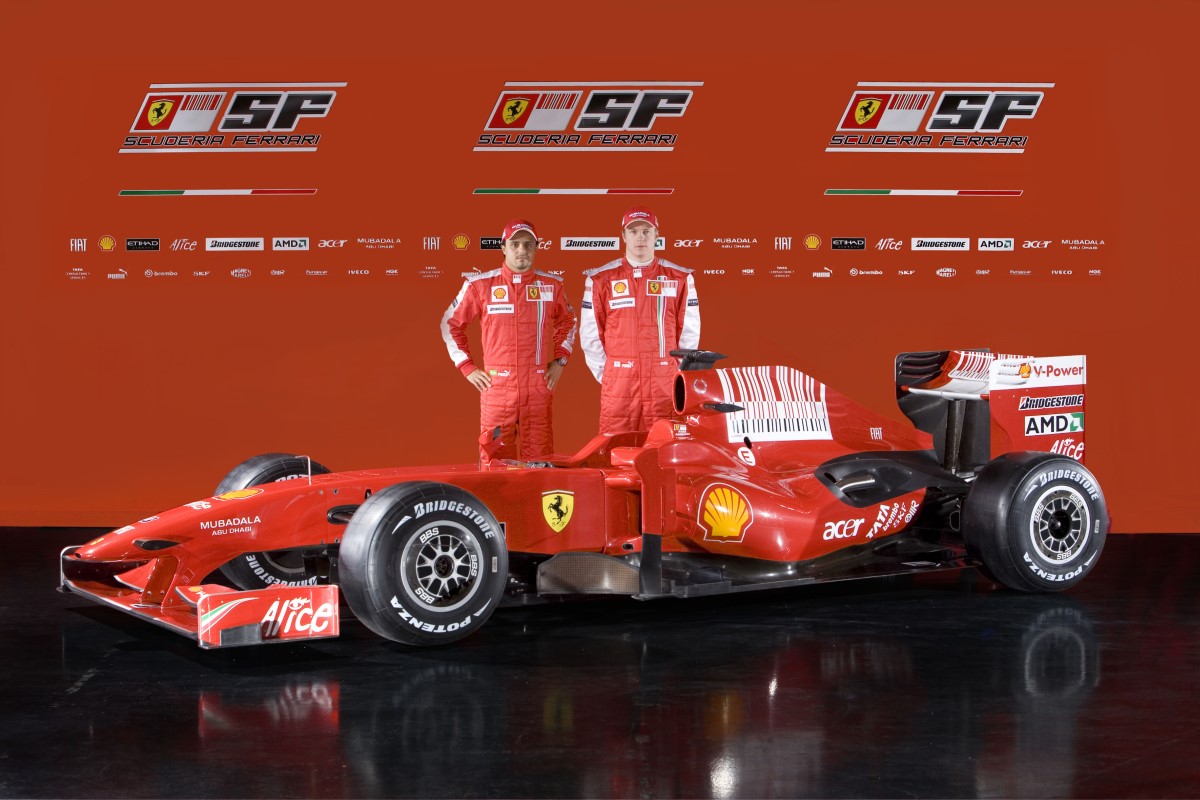Ferrari unveils the F60
 |
| Felipe Massa and Kimi Raikkonen pose with the new F60 Ferrari |
10:35am: the sound of the 056, the new F60's engine, interrupts the silence at the Mugello circuit's box. Just one lap for the new single-seater of the Prancing Horse, which has its first outing today at its official debut.
At 10:55am Felipe Massa went out for a second lap in the new F60, completing another whole lap. Yesterday, after he saw the new single-seater for the first time, with Stefano Domenicali and his teammate Raikkonen, at the logistics department at Fiorano, Massa said he was "happy and excited to take the Ferrari out for its first ride".
Both Ferrari race drivers Felipe Massa and Kimi Raikkonen have spoken of their optimism for 2009 following the launch of the new Ferrari F60 today. Speaking to the official F1 website, Massa talked of how his 2008 experience has made him stronger and how he will fight harder for the upcoming season’s crown.
“If you look at my career from the start to now, every year I feel stronger," he said. “I think after so much experience over these six years, I feel stronger and I feel more experienced, especially after last year, with how difficult the championship was. I think you learn, and that makes me ready and even more experienced for this year."
Massa was also moved to talk of his emotional connection with the Italian marque, with whom he starts his fourth season.
“When you race for Ferrari and you debut the car for the first time on the track it’s always quite an important and emotional day," explained the Brazilian to Ferrari’s official website. “It’s the second time in my career I’ve debuted the car for the first time and I am very proud.
“I was expecting quite a big car, like it was ten years ago for example, but when I got here the car is very small and compact, especially in the rear. It looks good and hopefully will be as quick as it looks like it."
Raikkonen, in typically blunt fashion, said that the new car’s different looks needed a little getting used to.
“(The car) looks different because of the new regulations, but I think after you look at it for a little while you get used to it. For me it looks different but very good, and I’m looking forward to running in it at the circuit tomorrow to see how it goes."
The Finn, whose performances were occasionally uncharacteristically mediocre in 2008, promised improvement. He is widely thought to be fighting for his seat for 2010, and said that he was intending to fight for the drivers’ crown again himself.
“Last year was not exactly what I wanted but it’s in the past," he explained. “Of course there’s a big question mark about who has the best car because the rules have changed a lot. But we are very confident the car should be very good and we should see in the next few weeks how good it is against the others. For sure we’ll try to win both championships.’’
Description and Technical Specifications
 |
| Front view of new F60 Ferrari |
The F60 is the fifty fifth single-seater built by Ferrari specifically to compete in the Formula 1 World Championship. The name of the car was chosen to celebrate the Scuderia's participation in all 60 editions of the Formula 1 World Championship since 1950 to date.
The project, which goes by the internal code name of 660, represents the Scuderia's interpretation of the regulations that come into force this year, which include very many new elements. As far as the aerodynamics are concerned, these modifications are the result of the work carried out by the OWG (Overtaking Working Group,) set up by the FIA in collaboration with the teams to produce a set of rules aimed at encouraging more overtaking on track: the front wing, which has a neutral central profile, common to all, is developed mainly on its side elements and is much wider than in the past: the bodywork can no longer carry the slotted apertures that had characterized the Ferrari cars over the past few years.
 |
| Side view of new F60 Ferrari |
Other aerodynamic devices are also significantly reduced; the rear wing is higher and narrower than in the past; the diffuser has been moved rearward. The combination of changes naturally led the initial design phase down radically different routes when it came to the side pods and protection components: the apertures have been reduced in size and moved rearward, while the upper and rear elements are larger to aid the exit of air.
The new rules regarding aerodynamics have also led to modifications to the suspension, as these elements can no longer be enclosed to the same extent. The suspension system and the whole layout of the car have been redesigned in the light of the new rules in order to achieve the correct weight distribution.
 |
| Top view of new F60 Ferrari |
The design also takes into account two other significant changes in the 2009 regulations: the possibility of using a kinetic energy recovery system (KERS) and the reintroduction of "slick" tires. The KERS on the F60 was designed by Ferrari in collaboration with Magneti Marelli and is centrally mounted on the engine under the rear part of the chassis; its management has involved all departments of the Gestione Sportiva. The return to tires with no grooves is another element which is down to the work of the OWG, as is the introduction of a flap on the front wing that can be adjusted by the driver when the car is moving.
The software for managing this tool, as well as for the KERS, was designed in Maranello. The transmission has been redesigned to optimize the aerodynamic efficiency of the car. The gearbox casing is again made in carbon and is still positioned longitudinally. The gearbox is fitted with a speed shifter. There is also a new braking system, with calipers designed by Brembo. Other important rule changes for this year stem from the work of FIA and FOTA (Formula One Teams Association) aimed at producing a significant reduction in the teams' operational costs. <BR>As far as the engine is concerned, which retains its longitudinal mounting in the F60 and continues as a load bearing structure, the rules now state that a total of eight engines may be used over the 17 Grand Prix race weekends on the calendar. |
Accordingly, the maximum permitted engine speed has been reduced to 18,000 rpm and the distance target for each unit is now around 2,500 kilometers. Furthermore, modifications have been made to the inlet trumpets, the position of the injectors and the configuration of the exhausts. The changes to the regulations mean that, on the reliability front, Shell has played a fundamental role in defining the lubricants for both the engine and gearbox.
As usual, the technical partners have played an important part right from the design and development stage of the entire car. Apart from the aforementioned Shell, a significant contribution has been made by the FIAT Research Centre, especially in the use of its simulation systems and by Brembo, in the development of the braking system. As usual, great attention has been paid to the management and optimization of the materials used, at the design stage and through quality control, aimed at maximizing performance while maintaining the highest possible levels of safety.
Technical specifications
Chassis
Construction: Carbon-fiber and honeycomb composite structure
Gearbox: Ferrari longitudinal, Limited-slip differential
Shifting: Semiautomatic sequential electronically controlled
Number of gears: 7 + Reverse
Brakes: Brembo ventilated carbon-fiber disc brakes
Suspension: Independent suspension, push-rod activated torsion springs front and rear
Weight (with water, lubricant and driver): 605 kg
Wheels: BBS Wheels (front and rear) 13"
KERS: by Ferrari in cooperation with Magneti Marelli
Engine
Designation: Type 056
Number of cylinders: 8
Architecture: Cylinder block in cast aluminum V 90°
Number of valves: 32, Pneumatic distribution
Total displacement: 2398 cc
Piston bore: 98 mm
Weight: > 95 kg
Injection: Magneti Marelli digital electronic injection
Ignition: Magneti Marelli static electronic ignition
Fuel: Shell V-Power ULG-66L/2
Lubricant: Shell
